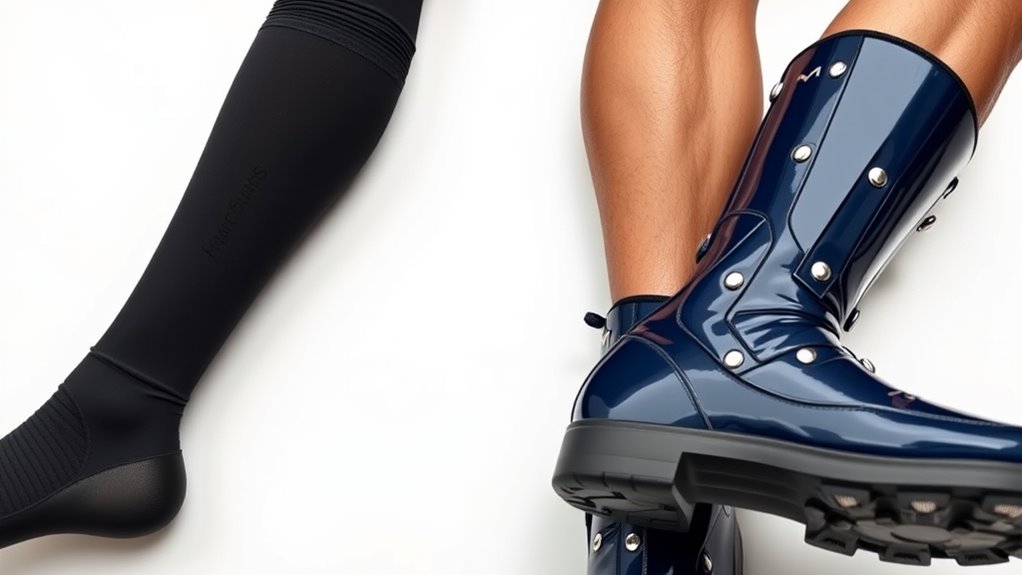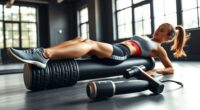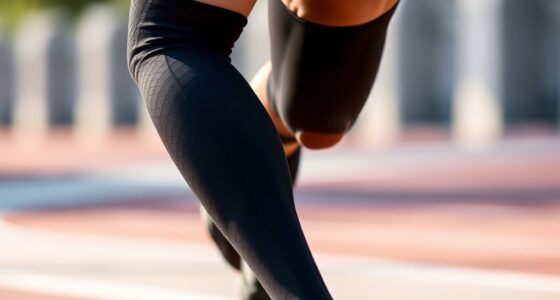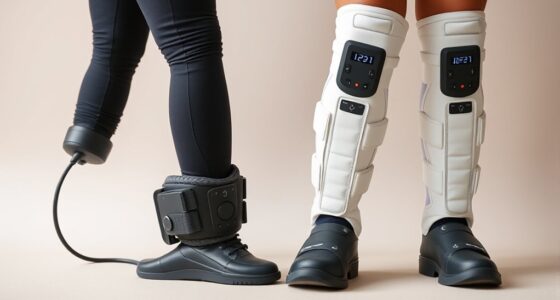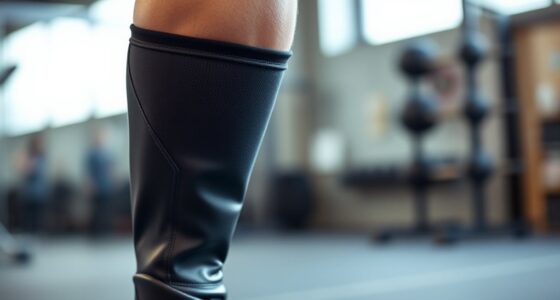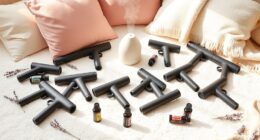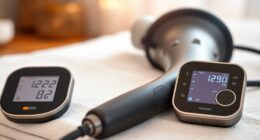If you’re choosing between compression sleeves and recovery boots, consider your needs. Sleeves are lightweight, easy to wear, and perfect for targeted muscle support, while boots cover larger areas and provide more extensive compression through pulsating massage. Both boost circulation and reduce soreness, but boots tend to be pricier and bulkier. To find out which suits your recovery routine best, explore how each option works and fits your lifestyle more.
Key Takeaways
- Compression sleeves are lightweight, easy to wear, and ideal for targeted muscle support and mobility, while recovery boots provide comprehensive coverage with adjustable pressure.
- Boots generally deliver more extensive circulation benefits due to sequential inflation, but sleeves are more portable and quicker to use.
- Sleeves are less expensive and require minimal maintenance, whereas boots involve higher upfront costs and potential ongoing upkeep.
- For active travelers or quick recovery sessions, sleeves offer convenience; boots are better suited for in-depth recovery at home or post-intensive training.
- The choice depends on individual needs: sleeves suit those prioritizing mobility and portability; boots favor athletes seeking full-leg compression and maximal circulation boost.
Understanding How Compression Sleeves Work

Compression sleeves work by applying graduated pressure to your limbs, which helps improve blood flow and reduce muscle fatigue. This targeted pressure enhances circulation, ensuring oxygen-rich blood reaches your muscles faster. The compression benefits include faster recovery, decreased soreness, and minimized swelling. Sleeve materials play a *fundamental* role in how effective the compression is; high-quality fabrics like nylon, spandex, or lycra provide the necessary elasticity and durability. These materials also wick away sweat, keeping you comfortable during workouts or recovery. The snug fit of compression sleeves supports muscles and joints without restricting movement. Overall, understanding how sleeve materials influence compression benefits helps you choose gear that maximizes recovery and performance. Properly designed sleeves deliver consistent, effective pressure tailored to your needs. For those interested in optimizing their gear, exploring Hyundai Tuning options can inspire innovative modifications for enhanced performance and durability.
The Mechanism Behind Recovery Boots

Recovery boots work by applying controlled, pulsating pressure to your limbs, which helps enhance circulation and promote faster healing. This process is a form of compression therapy, where the boots inflate and deflate in sequence, squeezing your muscles to improve blood flow. Increased circulation delivers oxygen and nutrients more efficiently, supporting muscle regeneration after intense activity. The rhythmic pressure also helps flush out metabolic waste products like lactic acid, reducing soreness and swelling. Unlike static compression, the pulsating action mimics natural muscle movements, encouraging lymphatic drainage and fluid removal. This combination of improved blood flow and waste removal accelerates recovery, making recovery boots an effective tool for athletes and active individuals seeking quicker muscle repair and reduced downtime. Proper maintenance and care of the boots, including regular cleaning and filter checks, ensures consistent performance and effective recovery results.
Comparing Ease of Use and Portability
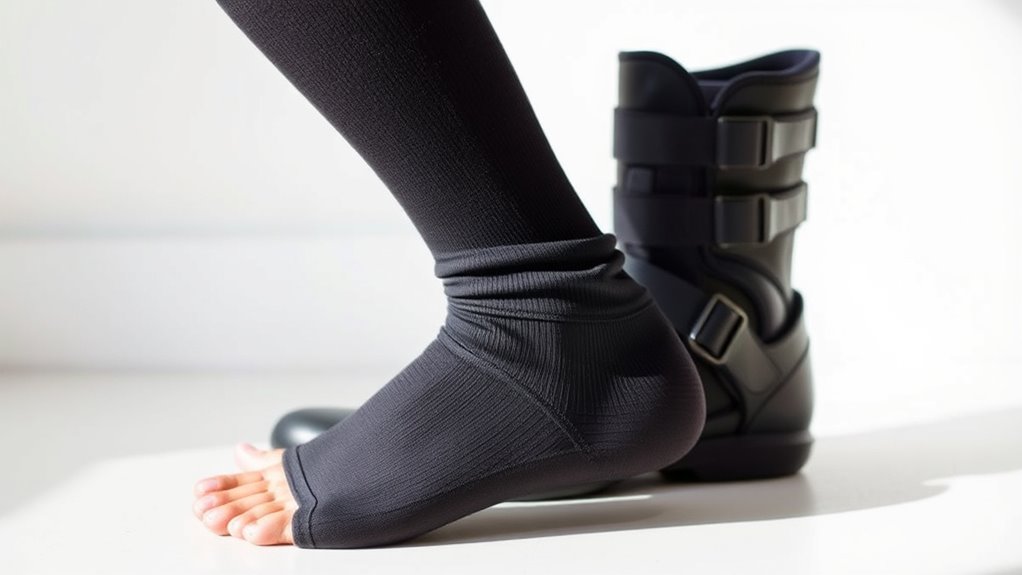
When choosing between compression sleeves and boots, ease of setup and application matter. You’ll want to contemplate how portable each option is for travel and how simple it is to adjust for a comfortable fit. Let’s compare these aspects to see which suits your needs better. Additionally, understanding family dynamics can influence your decision if you consider factors like ease of use for individuals with varying levels of mobility or familiarity with medical devices.
Setup and Application
While both compression sleeves and boots are designed for ease of use, they differ markedly in setup and portability. Compression sleeves are simple to slide on and off, requiring minimal preparation, making them quick to apply after workouts. Boots, however, often need to be inflated and secured, which can take a few extra minutes. Material diversity affects how comfortable and easy they are to wear for extended periods. Brands vary in design, with some offering lightweight, travel-friendly options, and others focusing on durability. Additionally, the suction technology in some boots can influence how quickly they are ready for use and how portable they are during travel.
Portability and Travel
Compression sleeves stand out for their exceptional portability, making them easy to carry and use on the go. Their lightweight, compact design fits easily into bags or pockets, offering excellent travel convenience. Unlike boots, which often require more space and sometimes need to be disconnected or adjusted, sleeves can be quickly slipped on or off without hassle. This makes them ideal for active travelers or those with limited luggage space. Their portable design means you can pack them effortlessly for trips, workouts, or post-activity recovery sessions away from home. Whether you’re heading to the gym, traveling for work, or returning from a long flight, compression sleeves provide convenient, on-the-move recovery support without adding bulk or complexity to your travel gear. Additionally, projector technology advancements have made these sleeves even more adaptable to various recovery needs.
Adjustments and Fit
Adjustments and fit are essential factors that influence how easily you can use compression sleeves and boots. Proper fit ensures comfort and effective recovery, making fit customization and size adjustments critical. Compression sleeves typically offer straightforward fit customization with simple elastic materials, allowing quick size adjustments. Boots often feature adjustable straps or dials to tailor pressure and fit, but may require more time to perfect. Additionally, the Victorian-inspired aesthetic of some recovery gear can influence design choices, blending form with function. Consider these points:
- Sleeves slip on easily with minimal adjustments
- Boots may need fine-tuning for even compression
- Fit customization impacts comfort during use
- Size adjustments help accommodate different leg sizes
Ultimately, sleeves provide quick ease of use, while boots offer more precise fit adjustments, which can enhance recovery but may require more effort.
Benefits for Circulation and Muscle Recovery
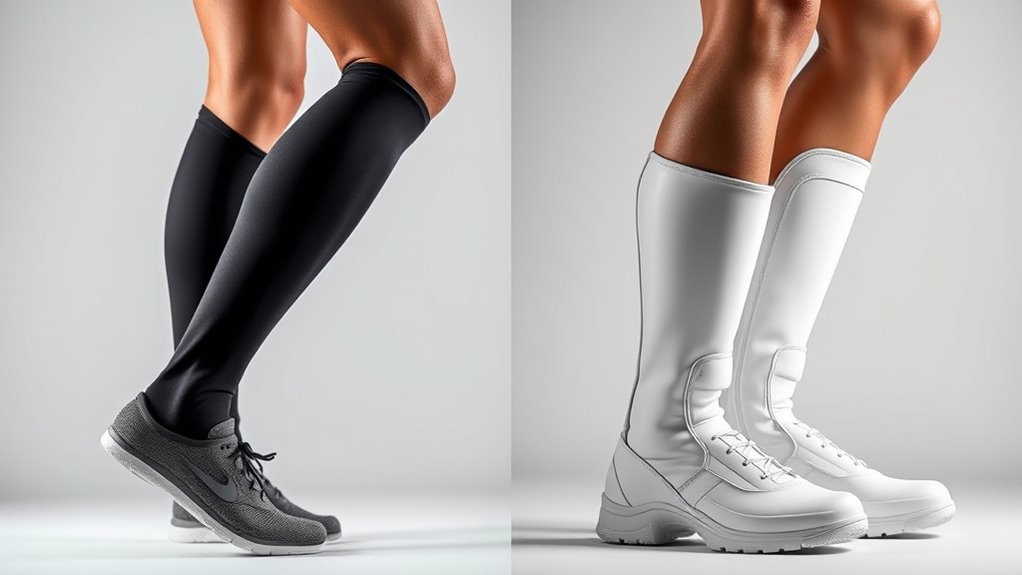
Using compression sleeves or boots can substantially boost circulation, helping blood flow more efficiently through your muscles and limbs. This enhanced circulation is a key benefit of compression therapy, as it delivers oxygen and nutrients faster to your tissues while removing metabolic waste. Improved blood flow accelerates your athletic recovery, reducing muscle fatigue and supporting tissue repair. Both sleeves and boots promote this process, but boots often cover larger areas, providing a more extensive benefit. Better circulation also helps prevent blood pooling and minimizes the risk of swelling after intense activity. By enhancing circulation, these recovery tools optimize your recovery time and keep you ready for your next workout. Overall, they’re effective options for supporting muscle health and speeding up recovery. Incorporating proper compression gear can also contribute to well-being by promoting overall physical health.
Impact on Soreness and Inflammation Reduction
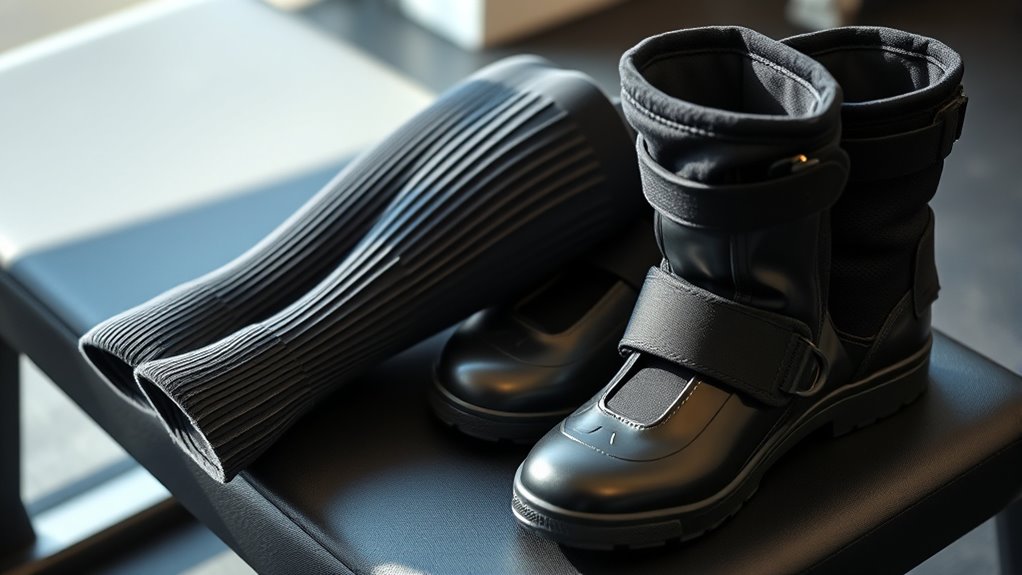
When you apply compression sleeves or boots after intense exercise, they can considerably reduce soreness and inflammation. This helps cut down on muscle fatigue and speeds up recovery. By promoting better blood flow, these gear types decrease swelling and support injury prevention. You’ll notice:
Applying compression sleeves or boots after exercise reduces soreness, speeds recovery, and prevents injuries through improved blood flow.
- Reduced muscle soreness, allowing you to train harder sooner
- Less inflammation, which lowers the risk of injury
- Faster removal of metabolic waste products
- Improved circulation that keeps muscles healthy and ready for next activity
- Many models incorporate advanced compression technology to enhance recovery benefits
Both sleeves and boots provide compression that targets sore areas, helping you feel less stiff and more prepared for your next workout. Choosing the right recovery gear can make a real difference in how quickly you bounce back and avoid setbacks.
Suitability for Different Types of Athletes
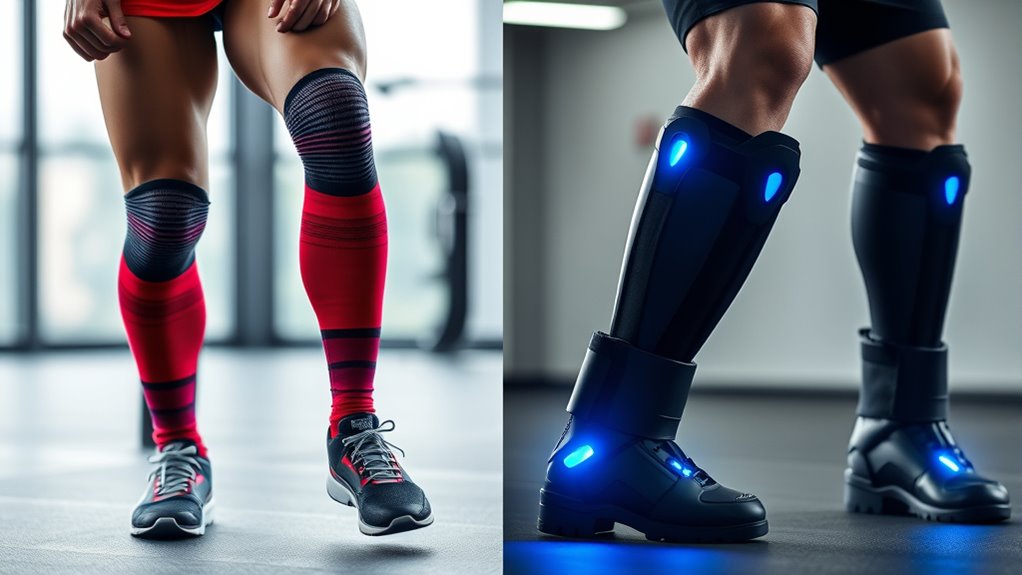
Different athletes have unique needs when it comes to recovery gear like compression sleeves and boots. Your athlete specialization influences which option suits you best. Endurance athletes, such as runners and cyclists, often prefer compression sleeves for targeted muscle support and mobility during recovery. Strength athletes may lean toward boots for full-leg compression, helping reduce swelling after intense sessions. Recovery preferences also matter—if you value portability and ease of use, sleeves are more convenient; if you seek all-encompassing coverage, boots might be better. Your training intensity and injury history can shape your choice, too. Ultimately, understanding your specific recovery needs ensures you select gear that enhances your performance and recovery process effectively.
Cost and Investment Considerations
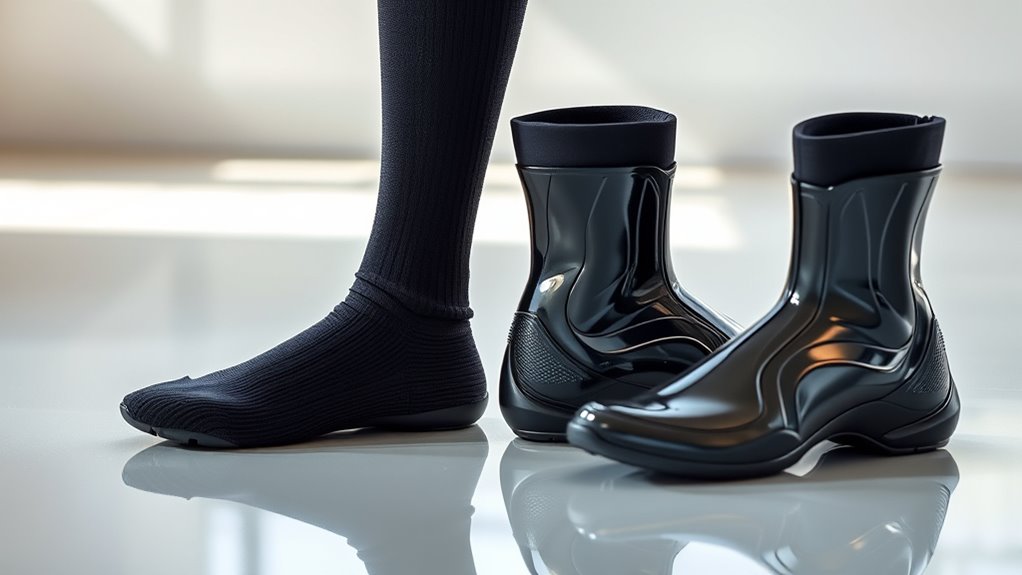
When choosing between compression sleeves and boots, considering cost-effectiveness is essential to get the best value for your money. Think about how each option fits into your long-term investment in recovery and injury prevention. Making a smart choice now can save you money and effort down the road. Additionally, evaluating the durability and maintenance requirements of each gear can influence their overall cost and longevity.
Cost Effectiveness
While compression sleeves and boots vary in upfront costs, evaluating their long-term value is essential for making an informed investment. Considering the price comparison helps you understand which offers better value over time, especially when factoring in maintenance costs.
- Compression sleeves generally cost less initially but may need replacement more often.
- Boots tend to have a higher upfront price but often last longer with proper care.
- Maintenance costs for sleeves are minimal, mostly washing and occasional repairs.
- Boots might require regular cleaning and occasional component replacements, adding to expenses.
- Incorporating cost-effective strategies can help optimize your investment in recovery gear.
Long-term Investment
Considering the long-term investment in compression sleeves versus boots requires examining both their initial costs and durability. Your choice depends on athlete preferences and brand reputation, which influence quality and longevity. Compression sleeves often cost less upfront but may need replacement sooner, especially if worn frequently. Boots, while more expensive initially, tend to last longer and provide consistent support. To help evaluate, consider this table:
| Feature | Compression Sleeves | Compression Boots | Longevity & Cost |
|---|---|---|---|
| Initial Cost | Lower | Higher | Boots are pricier upfront |
| Durability | Moderate | High | Boots last longer |
| Athlete Preference | Flexible, lightweight | Supportive, stable | Depends on needs |
| Brand Reputation | Varies | Often trusted | Reputable brands last |
| Maintenance | Easy to clean | Requires care | Boots often require more upkeep |
Additionally, choosing gear with proven quality standards can enhance long-term durability and performance. Your decision hinges on balancing initial spending with long-term value, guided by your athlete preferences.
Scientific Evidence Supporting Their Effectiveness
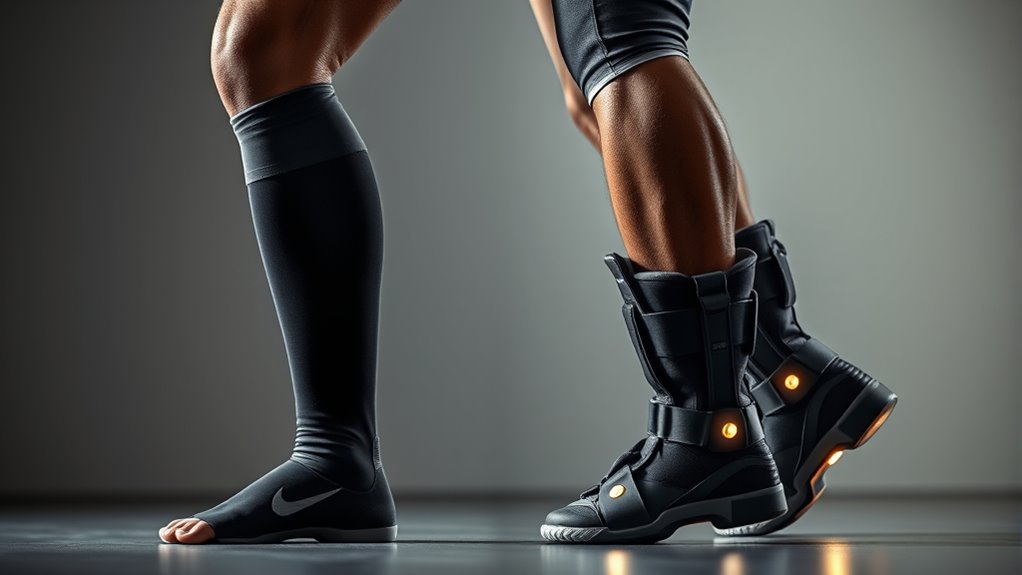
Numerous studies have investigated the effectiveness of compression sleeves and boots in enhancing recovery and performance. Research shows mixed results, but some key findings stand out. Athletes often prefer gear that feels comfortable and fits well, affecting their recovery experience. Material durability plays a role in long-term use, with high-quality fabrics lasting through multiple washes and workouts. You might notice that:
- Compression sleeves improve blood flow and reduce muscle soreness post-exercise
- Boots aid in faster removal of metabolic waste, supporting quicker recovery
- Material durability influences how long your gear remains effective
- Athlete preferences often sway the choice, balancing effectiveness with comfort and longevity
While evidence varies, many athletes report benefits, especially when gear aligns with their needs for durability and comfort. Additionally, choosing high-quality fabrics can ensure that recovery gear maintains its effectiveness over time.
Potential Drawbacks and Limitations
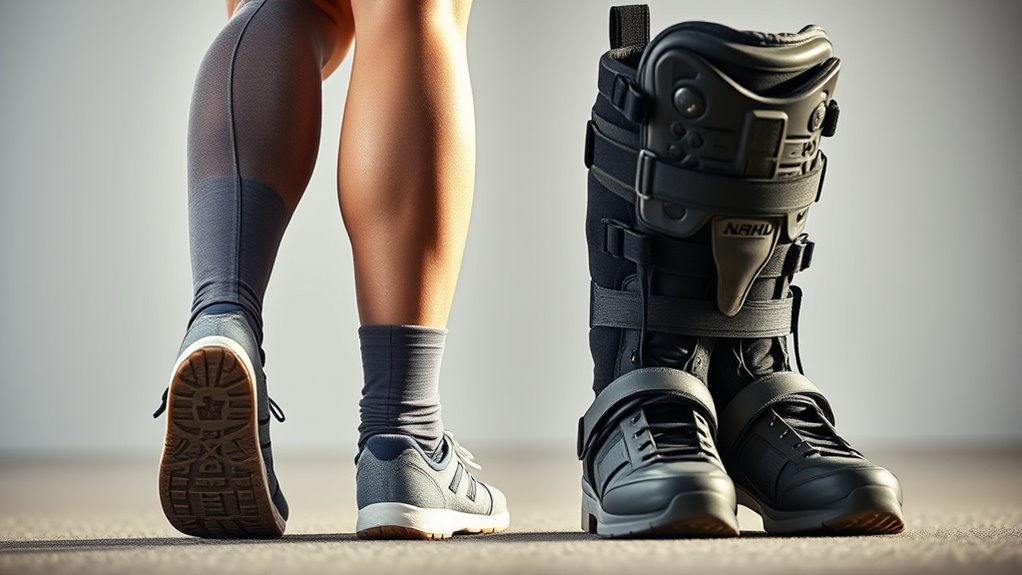
Despite the potential benefits, compression sleeves and boots come with limitations that can affect their overall usefulness. One common issue is skin irritation, which occurs if the gear fits too tightly or if you have sensitive skin. Prolonged use might cause redness, itching, or discomfort, making it harder to wear them consistently. Additionally, some people experience restricted movement, especially with boots that cover the entire lower leg or foot. This restriction can interfere with daily activities or cause discomfort during recovery sessions. Moreover, not everyone responds equally to compression therapy, and overuse may lead to skin issues or dependency on the gear for relief. It is also important to consider that compression technology effectiveness can vary depending on individual needs and proper fit, which underscores the importance of selecting the right gear for your recovery. Recognizing these limitations helps you make more informed decisions about incorporating compression gear into your recovery routine.
Making the Best Choice for Your Recovery Routine
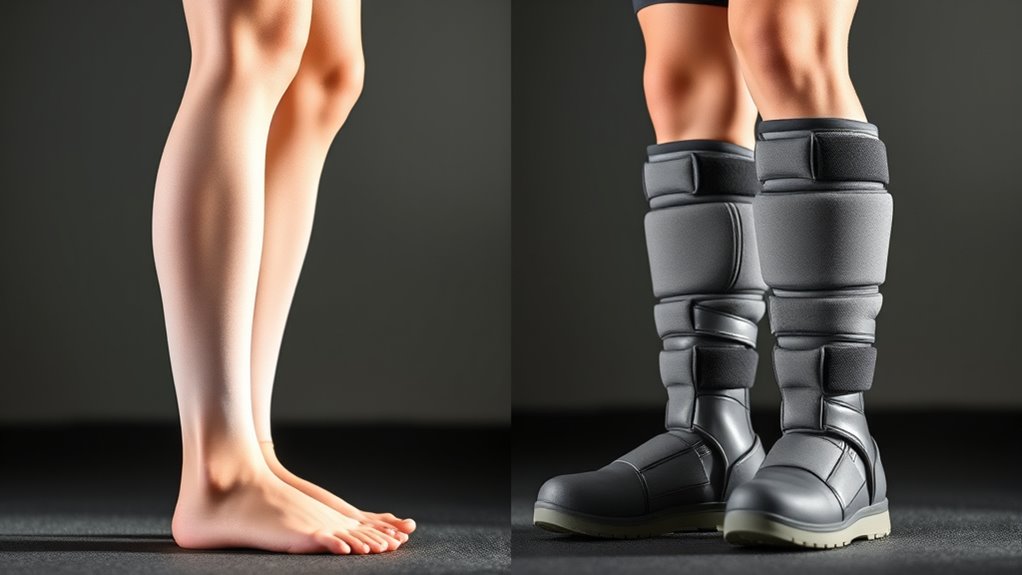
Choosing the right compression gear depends on your specific recovery needs and daily activities. To make an informed decision, consider how each option addresses muscle fatigue and injury prevention.
- If you need targeted compression for specific muscles after intense workouts, sleeves offer precise support.
- For full-leg recovery during longer sessions or sleep, boots provide extensive coverage.
- Think about your activity level—active athletes may benefit from sleeves for quick recovery, while boots suit those with prolonged fatigue.
- Budget and convenience matter; sleeves are portable and easier to wear on the go, whereas boots may require more setup.
- Incorporating evidence‑based practices, such as compression therapy, can enhance recovery outcomes and reduce muscle soreness.
Ultimately, selecting the gear that aligns with your routine ensures faster recovery, reduces muscle fatigue, and minimizes injury risk.
Frequently Asked Questions
Can Compression Sleeves Be Used During Actual Athletic Performance?
You can wear compression sleeves during athletic performance because they help improve circulation and reduce muscle vibration, which may enhance endurance. While they’re primarily used for recovery, many athletes find that compression sleeves provide support and comfort during activity. Just verify they fit well and don’t restrict movement. Overall, compression sleeves can be a helpful addition to your gear, but listen to your body to avoid discomfort or circulation issues.
How Long Should Each Recovery Session Last With Either Gear?
Imagine your muscles relaxing after a long run, the clock ticking softly. For ideal recovery, aim for a session duration of 20 to 30 minutes with either gear. Personalize your recovery time based on your activity level and comfort, listening to how your body responds. Longer sessions may help with swelling, but too long can cause discomfort. Stay attentive to your body’s signals for the best results.
Are There Specific Brands That Outperform Others in Effectiveness?
When comparing brands, you’ll find that some stand out in effectiveness ratings. Brand comparisons show that high-quality options like Normatec or Rapid Reboot often deliver better recovery results than lesser-known brands. You should look for reviews highlighting effectiveness, durability, and comfort. Ultimately, choosing a reputable brand can enhance your recovery, ensuring you get the most benefits from your gear and helping you return to peak performance faster.
Do Recovery Boots Require Professional Supervision for Optimal Results?
You might wonder if recovery boots need professional oversight for the best results. While they’re generally safe for personal use, safety considerations are important. Following the manufacturer’s instructions helps prevent misuse or injury. If you have underlying health conditions or experience discomfort, consulting a professional ensures safe, effective recovery. In some cases, professional supervision can optimize outcomes and address any concerns, giving you peace of mind during your recovery routine.
Can Combining Both Gear Types Enhance Overall Recovery?
Thinking combining recovery gear is overkill? Think again. Using both compression sleeves and boots offers dual benefits, maximizing your recovery potential. This combined strategy targets different areas and enhances circulation faster than single gear alone. Don’t underestimate the power of layered recovery—sometimes, more is more. So, yes, mixing both can boost your recovery, making you feel better, sooner. Who knew that a little extra effort could pay off so well?
Conclusion
Choosing between compression sleeves and recovery boots depends on your needs and preferences. Did you know that studies show compression therapy can reduce muscle soreness by up to 30%? Whether you prefer the portability of sleeves or the all-encompassing coverage of boots, both gear types can boost circulation and aid recovery. Consider your budget, convenience, and recovery goals to make the best choice. Either way, investing in quality recovery gear helps you bounce back faster and perform at your best.
